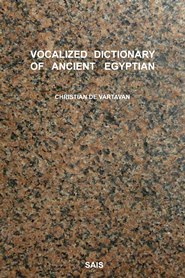| Main » Ad Board » ДРЕВЕН ЕГИПЕТ И АФРИКА » Език и писменост |
| 25.05.2020, 06:26 | |
Вокализиран речник на древноегипетския език от известния британски египтолог от арменски произход и основоположник на тази дисциплина в Армения - Кристиан де Вартаван (р. 1965). Christian de Vartavan - Vocalized Dictionary of Ancient Egyptian, London, Sais Books, 2016 а древноегипетски език (йероглифи и латинска транслитерация) и английски език, от Academia.Edu, формат PDF.Сваляне с ляв бутон (downloading by left button) и после през бутона Download. Academia.Edu изисква регистрация или влизане през Фейсбук/Google акаунт за сваляне на файловете/ Academia.Edu needs a registration (you can use the Facebook or Google account) for downloading. АЛТЕРНАТИВЕН ЛИНК / ALTERNATIVE LINK: Christian de Vartavan - Vocalized Dictionary of Ancient Egyptian, London, Sais Books, 2016 АЛТЕРНАТИВЕН ЛИНК / ALTERNATIVE LINK: Christian de Vartavan - Vocalized Dictionary of Ancient Egyptian, London, Sais Books, 2016 - на древноегипетски език (йероглифи и латинска транслитерация) и английски език, от Google Docs,формат PDF. Сваляне с ляв бутон (downloading by left button) от страницата на предоставящия сървър, после през бутона стрелка надолу/after by down arrow button.
| |
| Views: 1254 | Placed till: 25.06.2021 | Rating: 0.0/0 | |

